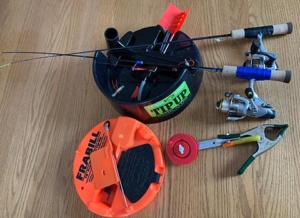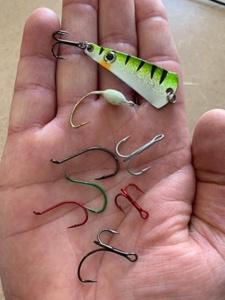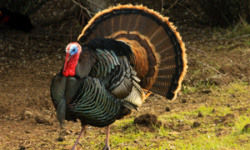By: Head Coach, Jason Revermann
Most of us don’t get to fish only when the bite is hot. We have to fish when time allows, so sometimes a scheduled trip falls smack dab in the beginning of a cold front. That means working for every bite. How to beat the odds? First, be in the right area. Cold fronts can push fish deeper off their primary structure, and if you’re not marking fish, start searching. Relocate to deeper water away or try finding structure in deeper depths. Make sure you are marking fish: You can’t catch what isn’t there!

Lots of options when it comes to set-lines; rattle reels, tip-ups, a jig under a bobber, an IFish Pro, and more.
Once you locate fish, determine what will trigger bites. Try what had been working on one line, then have a second line (where allowed) with another presentation. I usually have a fluttering jigging spoon on one rod and a set-line (dead-stick, tip-up, rattle reel, or an IFish Pro), in a nearby hole. Use that set-line nearby to catch fish you’re attracting with your jigging action. Or place it farther off on another part of the same structure.
There are many ways to vary set-lines. Use different length leaders, vary hook styles, adjust depth from the bottom, or try different bait types.
In clear water I prefer longer fluorocarbon leaders to eliminate line shyness. When it comes to hooks you have lots of options. Try different colors, sizes, octopus hooks, treble hooks, circle hooks, weighted hooks, or spoons.

Some of hooks that use on set-lines depending on the type of bait and the bite.
You can also adjust the amount of weight you put on the line and also how close your weight is to the minnow. When the bite gets tough it’s usually better to put the weight closer to the minnow so it can’t flee a finicky walleye. Also try using a weighted hook or a spoon to keep your minnow pinned down.
Normally I place the minnow about 2 feet off bottom so fish can see it from farther away, but when the fish are belly-to-the-bottom, it’s better to keep it closer to the bottom. There are times where a minnow sitting right on the bottom flapping its tail creating puffs of silt will convert a wary walleye into a biter.
There are a number of different types of minnows to consider. Fatheads and shiners are most common but you can also try suckers, rainbows, or even small crappie minnows. Experiment with different minnow types and sizes to see just what produces strikes.
Having a sonar down the hole with a set-line can reveal if fish are checking out, but then ignoring, your minnow. An underwater camera gives you a firsthand view to exactly how fish are responding. If you are marking fish, but not getting strikes, change things up!
That’s a lot of variables when it comes to set-lines, and you also have your jigging rod to think about. I will talk more about dialing in your jigging technique next week.
Good luck fishing and stay safe!






